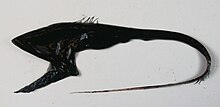
A leptocephalus is the flat and transparent larva of the eel, marine eels, and other members of the superorder Elopomorpha. This is one of the most diverse groups of teleosts, containing 801 species in 4 orders, 24 families, and 156 genera. This group is thought to have arisen in the Cretaceous period over 140 million years ago.

The pelican eel is a deep-sea eel. It is the only known member of the genus Eurypharynx and the family Eurypharyngidae. It belongs to the "saccopharyngiforms", members of which were historically placed in their own order, but are now considered true eels in the order Anguilliformes. The pelican eel has been described by many synonyms, yet nobody has been able to demonstrate that more than one species of pelican eel exists. It is also referred to as the gulper eel, pelican gulper, and umbrella-mouth gulper. The specific epithet pelecanoides refers to the pelican, as the fish's large mouth is reminiscent of that of the pelican.

The superorder Elopomorpha contains a variety of types of fishes that range from typical silvery-colored species, such as the tarpons and ladyfishes of the Elopiformes and the bonefishes of the Albuliformes, to the long and slender, smooth-bodied eels of the Anguilliformes. The one characteristic uniting this group of fishes is they all have leptocephalus larvae, which are unique to the Elopomorpha. No other fishes have this type of larvae.

Saccopharynx is a genus of deep-sea eels with large mouths, distensible stomachs and long, scaleless bodies. Commonly, these fish are called gulpers or gulper eels. It is the only genus in the family Saccopharyngidae, and is part of the derived lineage of the "saccopharyngiforms," which includes other mid-water eel species. The name is from Latin saccus meaning "sack" and Greek φάρυγξ, pharynx.
Cyema is a monospecific genus of marine ray-finned fish belonging to the monotypic family Cyematidae. The only species in the genus is Cyema atrum, the arrow eel, bobtail eel, bobtail snipe eel or deepwater eel. This species has circumglobal distribution.

Monognathus, or onejaw, is the only genus of the family Monognathidae of deep-sea eels. The name comes from the Greek monos meaning “one” and gnathos meaning “jaw”, a reference to the large mouth in comparison with the rest of the fish, and also the absence of an upper jaw.
Anguilloidei is a suborder of ray-finned fishes belonging to the order Anguilliformes, the eels.

The southern conger is a conger of the family Congridae, found in the eastern Indian Ocean and south-western Pacific Ocean, including southern Australia and New Zealand, at depths down to 100 m in broken rocky reef areas. Length is up to 2 m and weight may be up to 5 kg.

Ernst Johannes Schmidt was a Danish biologist credited with discovering in 1920 that European eels migrate to the Sargasso Sea to spawn. Before this people in North America and Europe had wondered where the small glass eels, or elvers, came from.

Eels are ray-finned fish belonging to the order Anguilliformes, which consists of eight suborders, 20 families, 164 genera, and about 1000 species. Eels undergo considerable development from the early larval stage to the eventual adult stage and are usually predators.
Ariosoma bauchotae is an eel in the family Congridae. It was described by Christine Karrer in 1983. It is a marine, deep water-dwelling eel which is known from waters northwest of Madagascar, in the western Indian Ocean. It is known to dwell at a depth range of 308–314 metres.
The Gilbert's garden eel, also known as the Gilbert's conger and the sharpnose conger, is an eel in the family Congridae. It was described by James Douglas Ogilby in 1898, originally under the genus Congrellus. It is a tropical, marine eel which is known from the eastern central and southeastern Pacific Ocean, including the Gulf of California, Costa Rica, El Salvador, Ecuador, Guatemala, Mexico, Honduras, Nicaragua, Panama, and Colombia. It is a benthic and nocturnal species, and inhabits sand flats in reefs, bays and coves at a depth range of 1–100 metres. It burrows into sand during the day and emerges to forage during the night. Males can reach a maximum total length of 27 centimetres.
Ariosoma meeki is an eel in the family Congridae. It was described by David Starr Jordan and John Otterbein Snyder in 1900, originally under the genus Congrellus. It is a subtropical, marine eel which is known from Japan and the Peng-hu Islands, in the northwestern Pacific Ocean. Males are known to reach a maximum total length of 53 centimetres.
The silver eel, also known as the Melliss's conger, is an eel in the family Congridae. It was described by Albert Günther in 1870. It is a rare tropical, marine eel which is known solely from St. Helena, in the southeastern Atlantic Ocean. It is known to dwell at a maximum depth of 67 meters. Males can reach a maximum total length of 42.8 centimetres.
Ariosoma sereti is an eel in the family Congridae. It was described by Emma Stanislavovna Karmovskaya in 2004. It is a marine, deep water-dwelling eel which is known from the Marquesas Islands, in the eastern central Pacific Ocean. It is known to dwell at a depth range of 95–370 metres. Females can reach a maximum total length of 26.5 centimetres.
The Bullish conger is an eel in the family Congridae. It was described by David G. Smith and Robert H. Kanazawa in 1977, originally under the genus Rhechias. It is a marine, deep water-dwelling eel which is known from the Gulf of Mexico to the Amazon, in the western Atlantic Ocean. It dwells at a depth range of 366–475 meters. Males can reach a maximum total length of 39.5 centimeters.
Gnathophis grahami, or Graham's conger, is an eel in the family Congridae. It was described by Emma Stanislavovna Karmovskaya and John Richard Paxton in 2000. It is a subtropical, marine eel which is known from New South Wales, Australia, in the southwestern Pacific Ocean. It dwells at a depth range of 50–350 metres.
The thread eel is an eel in the family Nemichthyidae. It was described by Marie-Louise Bauchot in 1959. It is a marine, temperate water-dwelling eel which is known from the Indo-Pacific and Chile in the southwestern Pacific Ocean. It is known to dwell at a depth of 1,750 metres (5,740 ft).
Neocyematidae is a family of fishes in the order Anguilliformes. This family, established from five described adult specimens of the species Neocyema erythrosoma, was originally thought to be a part of the family Cyematidae, until genomic sequencing in 2018 refuted this relationship.
Phillip Clarence Heemstra was an American-South African ichthyologist. He was born in Melrose Park, Illinois, United States as the son of Clarence William Heemstra and his wife, Lydia. He attended school in Ottawa, Illinois, and completed a B.Sc. Zoology in 1963 at the University of Illinois at Urbana, Illinois, as well as his MSc degree (1968) and doctorate (1974) in marine biology at the University of Miami in Miami, Florida. He moved to live in South Africa in 1978.








